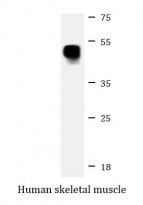ARG40887
anti-Wnt11 antibody
anti-Wnt11 antibody for Western blot and Human
Overview
| Product Description | Rabbit Polyclonal antibody recognizes Wnt11 |
|---|---|
| Tested Reactivity | Hu |
| Tested Application | WB |
| Host | Rabbit |
| Clonality | Polyclonal |
| Isotype | IgG |
| Target Name | Wnt11 |
| Antigen Species | Human |
| Immunogen | KLH-conjugated synthetic peptide between aa. 166-198 of Human Wnt11. |
| Conjugation | Un-conjugated |
| Alternate Names | Protein Wnt-11; HWNT11 |
Application Instructions
| Application Suggestion |
|
||||
|---|---|---|---|---|---|
| Application Note | * The dilutions indicate recommended starting dilutions and the optimal dilutions or concentrations should be determined by the scientist. | ||||
| Observed Size | ~45 kda |
Properties
| Form | Liquid |
|---|---|
| Purification | Purification with Protein A and immunogen peptide. |
| Buffer | PBS and 0.09% (W/V) Sodium azide. |
| Preservative | 0.09% (W/V) Sodium azide |
| Storage Instruction | For continuous use, store undiluted antibody at 2-8°C for up to a week. For long-term storage, aliquot and store at -20°C or below. Storage in frost free freezers is not recommended. Avoid repeated freeze/thaw cycles. Suggest spin the vial prior to opening. The antibody solution should be gently mixed before use. |
| Note | For laboratory research only, not for drug, diagnostic or other use. |
Bioinformation
| Database Links | |
|---|---|
| Gene Symbol | WNT11 |
| Gene Full Name | wingless-type MMTV integration site family, member 11 |
| Background | The WNT gene family consists of structurally related genes which encode secreted signaling proteins. These proteins have been implicated in oncogenesis and in several developmental processes, including regulation of cell fate and patterning during embryogenesis. This gene is a member of the WNT gene family. It encodes a protein which shows 97%, 85%, and 63% amino acid identity with mouse, chicken, and Xenopus Wnt11 protein, respectively. This gene may play roles in the development of skeleton, kidney and lung, and is considered to be a plausible candidate gene for High Bone Mass Syndrome. [provided by RefSeq, Jul 2008] |
| Function | Ligand for members of the frizzled family of seven transmembrane receptors. Probable developmental protein. May be a signaling molecule which affects the development of discrete regions of tissues. Is likely to signal over only few cell diameters. [UniProt] |
| Cellular Localization | Secreted, extracellular space, extracellular matrix. [UniProt] |
| Calculated MW | 39 kDa |
| PTM | Palmitoleylation is required for efficient binding to frizzled receptors. Depalmitoleylation leads to Wnt signaling pathway inhibition. [UniProt] |
Images (1) Click the Picture to Zoom In






